California is home to a variety of wasp species. While most of these wasps are harmless to humans, some can pack a wallop with their painful stings. From the notorious tarantula hawk wasp (Pepsis grossa) to the bald-faced hornet (Dolichovespula maculata), California’s wasp population can be both fascinating and intimidating. Whether you’re a nature enthusiast or just trying to enjoy a picnic, it’s important to be aware of these stinging insects and know how to avoid their painful attacks. Keep reading to learn how to identify these painfully annoying pests.
What is a Wasp?
Wasps are a diverse group of insects belonging to the order Hymenoptera, which also includes ants and bees. There are over 100,000 described species of wasps, with many more yet to be discovered and classified. Wasps vary greatly in size and shape. There are tiny parasitic wasps that are less than an inch long. There are also intimidating-looking hornets that can reach several inches in length. Many wasps are beneficial insects that play important roles in controlling pest populations, pollinating plants, and decomposing organic matter. However, some species can be a pain to humans. They can become aggressive if their nests are disturbed or if they feel threatened.
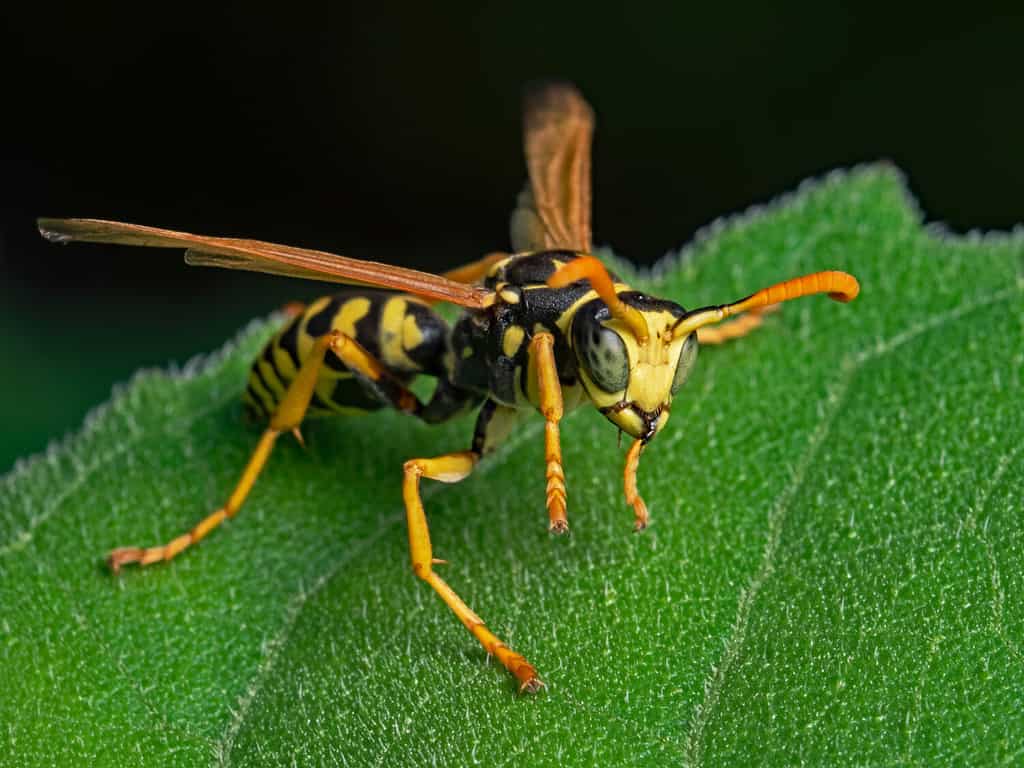
Wasps are a diverse group of insects belonging to the order
Hymenoptera, which also includes ants and bees.
©scubaluna/Shutterstock.com
Over 4,000 described species of wasps have been documented in California. These include a diverse array of wasp families. There are paper wasps (Polistinae), yellowjackets (Vespinae), mud daubers (Sphecidae), potter wasps (Eumeninae), cicada killers (Sphecius speciosus), and many others. To rate the pain of their stings we will be using the Schmidt Pain Index for Stinging Insects.
Schmidt Pain Index for Stinging Insects
The Schmidt Pain Index for Stinging Insects is a scale that ranks the relative pain caused by different insect stings. The index was created by Dr. Justin O. Schmidt, an entomologist at the Carl Hayden Bee Research Center in Tucson, Arizona. To create the index, Dr. Schmidt spent many years studying the stings of various insects.
Development of the Schmidt Pain Index for Stinging Insects
Dr. Schmidt allowed himself to be stung by different species of insects. He then recorded his observations on a scale of 1 – 4. The least painful sting is a 1. The most painful is 4. Dr. Schmidt used several criteria to rate the pain caused by each sting. He included the duration and intensity of the pain, as well as any other symptoms such as swelling or itching. After years of research and data collection, Dr. Schmidt compiled his findings into the Schmidt Pain Index for Stinging Insects. His index is now widely used by researchers and medical professionals to evaluate the severity of insect stings, thusly:
- Level 1 (mild pain): Insects in this category cause mild pain that is often described as a slight burning or itching sensation, such as from the sting of a sweat bee.
- Level 2 (moderate pain): Insects in this category cause more intense pain which is often described as a sharp, piercing sensation. Examples include yellow jackets and hornets.
- Level 3 (severe pain): Insects in this category cause severe pain that is often described as a deep, throbbing sensation. Examples include red paper wasps and velvet ants
- Level 4 (intense pain): Insects in this category cause the most intense pain, often described as an electric shock or being stabbed with a hot poker. Insects with the most painful stings include bullet ants, warrior wasps, and tarantula hawks.
Dr. Schmidt passed away on February 18, 2023, from complications related to Parkinson’s Disease. Read about his life here.
Types of Wasps In California Ranked By the Pain of Their Sting: Pain vs. Lethality
Wasp stings can be painful and uncomfortable. They can also cause some severe and potentially life-threatening reactions. However, it’s important to note that pain and lethality are two separate things when it comes to wasp stings.
Pain is a subjective experience and varies from person to person. Some people may experience mild discomfort, while others feel excruciating pain. The severity of the pain can also depend on various factors. These include the location of the sting, the size of the wasp, and individual pain tolerance.
On the other hand, lethality refers to the potential of the wasp sting to cause death. While wasp stings can be lethal in rare cases, they are not as deadly as some other insect stings. The stings of some bees can be more dangerous. The venom of some wasps can cause anaphylaxis, a severe and potentially life-threatening allergic reaction, but this is a relatively uncommon reaction.
It’s important to take proper precautions to avoid wasp stings, especially if you have a known allergy to them. If you do get stung, it’s essential to monitor your symptoms and seek medical attention if necessary. Although wasp stings are generally not lethal, they can still be painful and uncomfortable. And now, without further ado and falderal, we present Types of Wasps In California Ranked By the Pain of Their Sting.

Some people may experience mild discomfort, while others feel excruciating pain.
©kanoksak neamsum/Shutterstock.com
Types of Wasps In California Ranked By the Pain of Their Sting: Tarantula Hawk – 4
The tarantula hawk wasp (Pepsis grossa) is a species of large, solitary wasp belonging to the family Pompilidae. They are found in Southern North America, including California. The tarantula hawk is known for its impressive size, with females reaching up to 3 inches (7.5 cm) in length. They have black bodies with bright orange wings. Their sting is considered one of the most painful of any insect. The males of the species do not have stingers, but females possess ¼ inch (7mm) stingers.
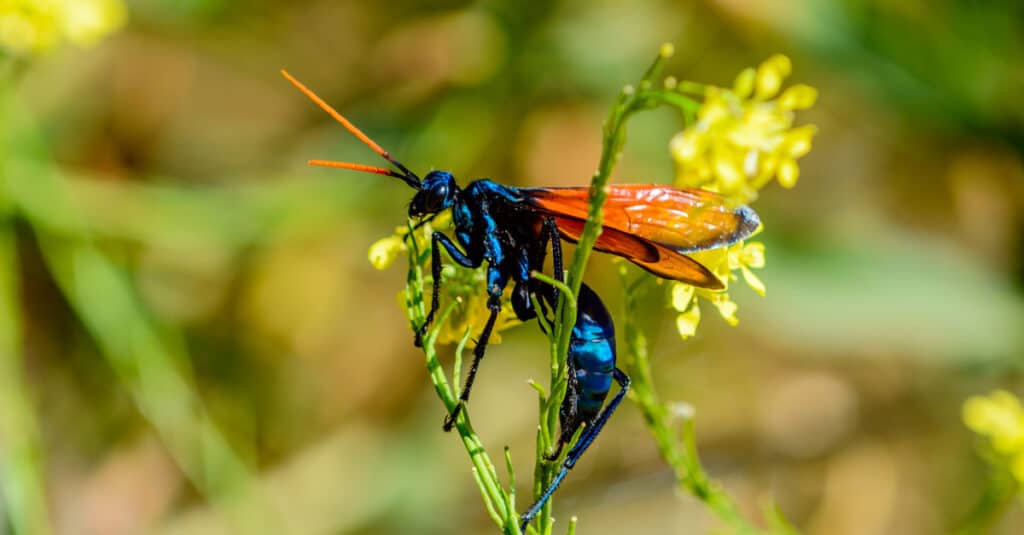
Tarantula hawks have black bodies with bright orange wings. Their sting is considered one of the most painful of any insect.
©Robert Briggs/Shutterstock.com
Tarantula Hawks: Behavior
Tarantula hawk females hunt tarantulas, which they paralyze with their sting before dragging them back to their nest. They then lay a single egg on the paralyzed tarantula. The tarantula serves as a food source for the developing wasp larva. The tarantula hawk is an important species for controlling tarantula populations, as they help keep their numbers in check. While they are known for their painful sting, tarantula hawk wasps are not considered aggressive toward humans. They will only sting if provoked or threatened.
The sting of the tarantula hawk wasp is classified as a 4.0. This is the most painful sting on the Schmidt Pain Index for Stinging Insects. Their venom contains a potent cocktail of neurotoxins that can cause intense pain, swelling, and redness around the sting site. Some people have described the pain as being similar to an electric shock. Others have likened the pain to a hot metal rod being driven through the affected area. Dr. Schmidt said of the sting, “Blinding, fierce, shockingly electric. A running hair dryer has just been dropped in your bubble bath.”
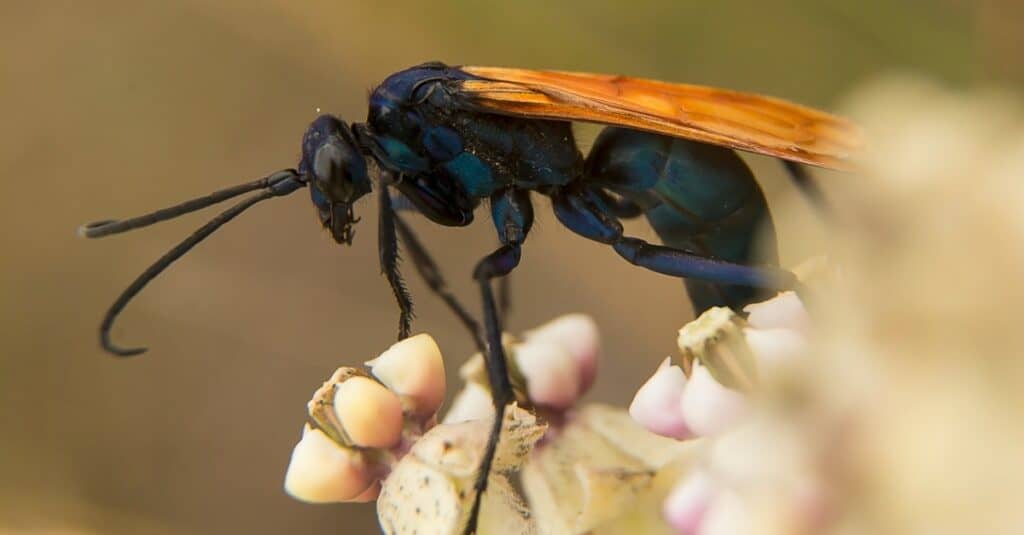
The sting of the tarantula hawk wasp is classified as a 4.0, the most painful sting, on the Schmidt Pain Index for Stinging Insects.
©iStock.com/Thom_Morris
The pain and other symptoms associated with the sting of the tarantula hawk wasp can last for several hours or even days, depending on the individual’s sensitivity to the venom and the location of the sting. In rare cases, an allergic reaction to the venom can occur. This can result in more severe symptoms such as difficulty breathing or a drop in blood pressure. If you are stung by a tarantula hawk wasp and experience symptoms such as difficulty breathing, swelling of the face or throat, or a severe allergic reaction, seek medical attention immediately.
Types of Wasps In California Ranked By the Pain of Their Sting: Cow Killer – 3.25
Dasymutilla occidentalis, the red velvet ant, or cow killer, is a species of parasitic wasp that is found throughout the Western United States, including California. Despite its name, the velvet ant is not actually an ant, but a type of wingless wasp. The females of the species are wingless and covered in dense, velvety hairs that can range in color from bright red to brownish-black. They are typically larger than males. Males have wings but lack stingers. So while males have a more wasp-like appearance, they are harmless. The bright coloration of the velvet ant is thought to serve as a warning to predators that they are capable of delivering a painful sting.
Velvet ants are solitary wasps that parasitize other insects, such as ground-nesting bees and wasps. The female velvet ant seeks out the nests of these insects and lays her eggs on the developing larvae. When the velvet ant larvae hatch, they feed on the host insect’s larvae before pupating and eventually emerging as adults.
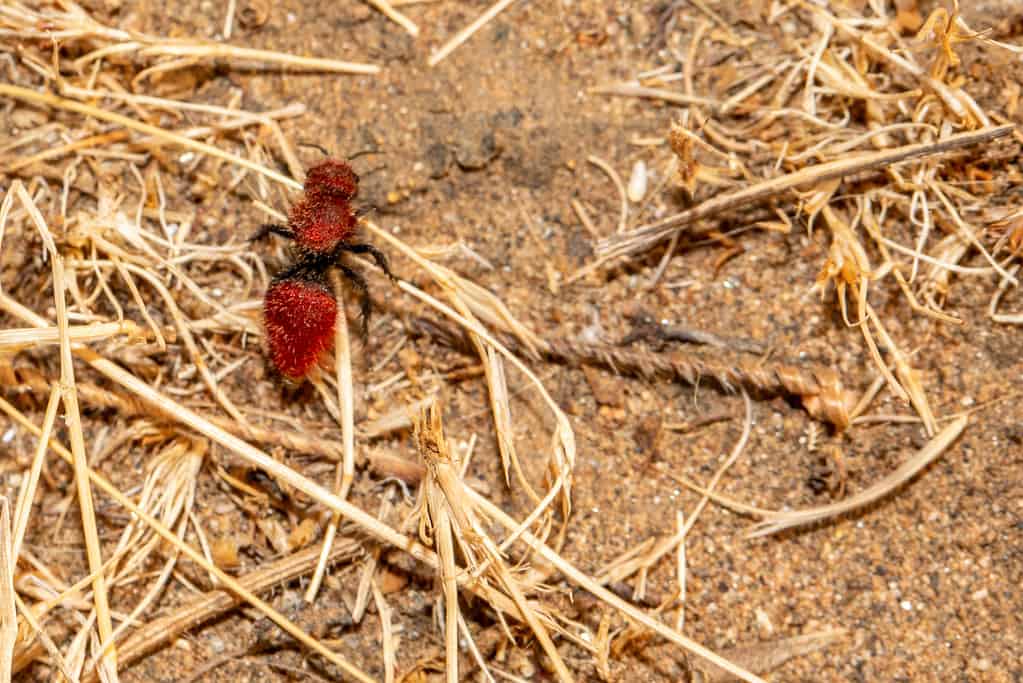
Despite its name, the velvet ant is not actually an ant, but a type of wingless wasp.
©Warren Parker/Shutterstock.com
The Sting
The extremely painful sting inflicted by the female Dasymutilla occidentalis, commonly known as the cow killer, ranks 3.25 on the Schmidt Pain Index. However, the name cow killer is somewhat misleading, as the sting is not actually capable of killing a cow or any other large animal. Nonetheless, the sting is quite painful and can cause a range of symptoms, including intense burning, swelling, and numbness, which can last for up to an hour.
Types of Wasps In California Ranked By the Pain of Their Sting: Coarse-Backed Red Paper Wasp – 3
California is home to 22 species of paper wasps. Depending on the species, the sting of the paper wasp ranks between 2-3 on Schmidt’s index. The sting of the coarse-backed red paper wasp (Polistes Carolina) is rated as a 3.0, which is considered severe. The pain caused by the sting of the coarse-backed red paper wasp is described as intense and burning, with some people experiencing localized swelling and redness around the sting site. According to Dr. Schmidt, the sting of the paper wasp is “caustic and burning with a distinctly bitter aftertaste.”
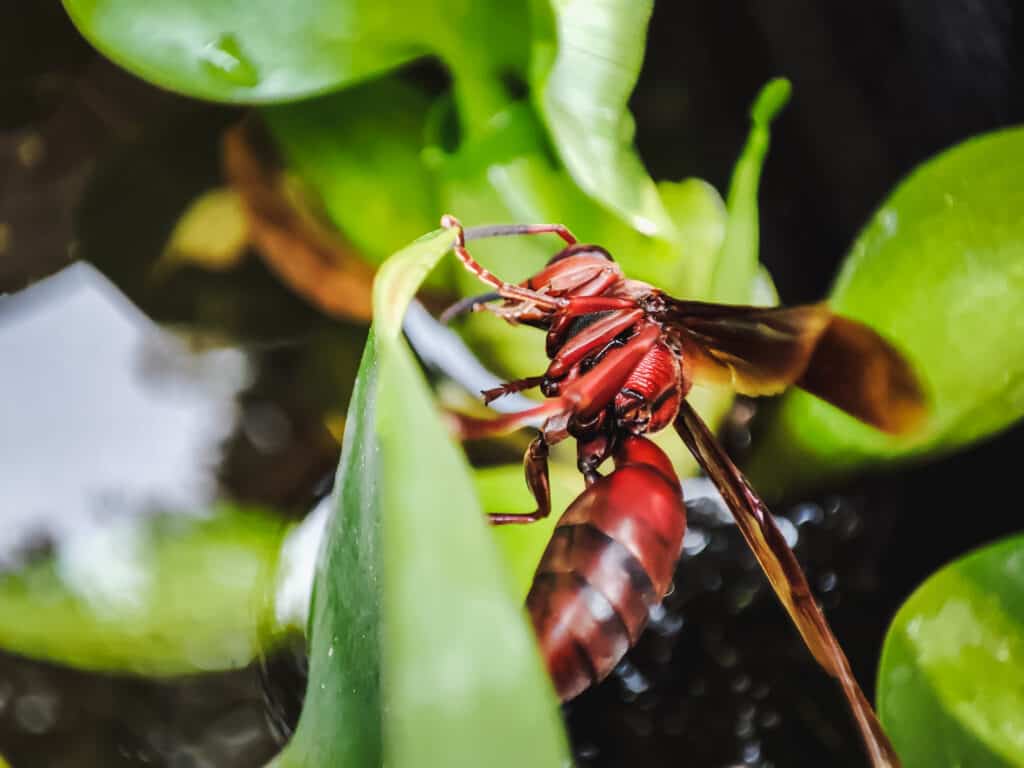
The sting of the coarse-backed red paper wasp (
Polistes Carolina) is rated as a 3.0, which is considered severe.
©iStock.com/Riki I Gunawan
Types of Wasps In California Ranked By the Pain of Their Sting: Thistledown Velvet Ant – 2
The thistledown velvet ant (Dasymutilla gloriosa) is a species of velvet ant that is found in the Southwestern United States, including California. Like other velvet ants, the thistledown velvet ant is known for its bright coloration and dense, velvety fur. The thistledown velvet ant has a reputation for delivering an excruciating sting, though still less painful than the sting of the cow killer. On the Schmidt Pain Index for Stinging Insects, the thistledown clocks a solid 2.0. The sting of the thistledown velvet ant can cause intense burning, swelling, and numbness. Only female thistledown velvet ants are capable of delivering a sting, as males do not have stingers.
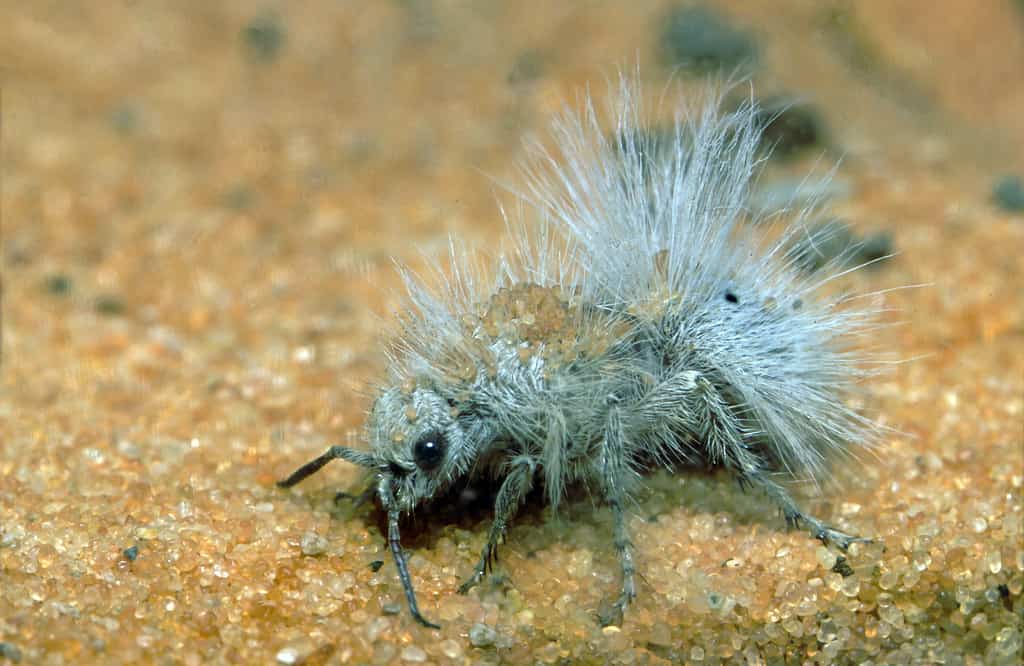
The sting of the thistledown velvet ant can cause intense burning, swelling, and numbness.
©iStock.com/EdwardSnow
Types of Wasps In California Ranked By the Pain of Their Sting: European Hornet /Bald-faced Hornet – 2
The European hornet (Vespa crabro) and the bald-faced hornet (Dolichovespula maculata) are both species of hornets that are found in North America. While these two species are not closely related, they share a similarity in that their stings are both quite painful, with a rating of 2.0 on the Schmidt Pain Index for Stinging Insects.
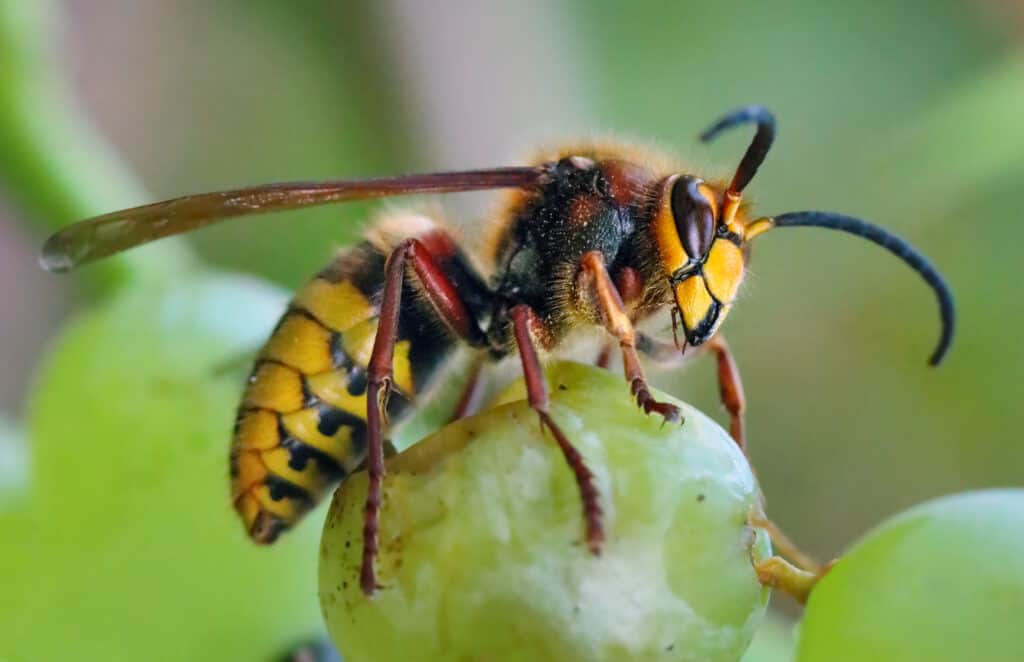
The sting of the European hornet (
Vespa crabro), according to Dr. Schmidt, feels “Like a matchhead that flips off and burns your skin.”
©TTstudio/Shutterstock.com
The European hornet is a relatively large species of hornet that is native to Europe and has been introduced to North America. Its sting is reported to be sharp and burning, with swelling and redness at the site of the sting. The sting of the European hornet, according to Dr. Schmidt, feels “Like a matchhead that flips off and burns your skin.” The bald-faced hornet is a social wasp that builds large, paper nests in trees and other structures. Its sting is reported to be sharp and long-lasting. There is a burning sensation and a raised welt at the site of the sting. While both the European hornet and the bald-faced hornet have painful stings, they are not generally aggressive unless they feel threatened or their nest is disturbed.

The bald-faced
hornet
is a social wasp that builds large, paper nests in trees and other structures.
©Ernie Cooper/Shutterstock.com
Types of Wasps In California Ranked By the Pain of Their Sting: Western Yellowjacket – 2
The Western yellowjacket (Vespula pensylvanica) is a species of social wasp that is found throughout Western North America, from Canada down to Mexico. It is known for its aggressive behavior when its nest is disturbed and for its painful sting, which ranks 2.0 on the Schmidt Pain Index for Stinging Insects.
The Western yellowjacket is a yellow and black wasp that builds nests in the ground or in other protected areas, such as in hollow trees or buildings. The nests are made from a paper-like material that the wasps create by chewing up wood and other plant materials.
If a Western yellowjacket feels threatened, it may sting repeatedly and release pheromones that signal other members of its colony to join in the attack. The sting of a Western yellowjacket is reported to be sharp and burning, with a raised welt at the site of the sting. In some cases, the sting can cause an allergic reaction which can be life-threatening.

The Western yellowjacket (
Vespula pensylvanica) is a species of social wasp that is found throughout Western North America, from Canada down to Mexico.
©Ernie Cooper/Shutterstock.com
Types of Wasps In California Ranked By the Pain of Their Sting: Western Cicada Killer – 1.5
The Western cicada killer (Sphecius grandis) is a large species of solitary wasp that is found throughout Western North America. Despite its size, the Western cicada killer is not typically aggressive toward humans and is considered relatively docile. Its sting is rated 1.5 on the Schmidt Pain Index, which is considered less painful than many other stinging insects.
The Western cicada killer is named for its habit of hunting cicadas, which it uses to feed its larvae. The female wasp captures cicadas in flight and stings them to paralyze them before carrying them back to her underground nest. Once there, she lays an egg on the paralyzed cicada, which serves as a food source for her developing larvae. Although the Western cicada killer has a relatively mild sting, it can still be painful and cause localized swelling and redness.

Despite its size, the Western cicada killer is not typically aggressive toward humans and is considered relatively docile.
©samray/Shutterstock.com
Types of Wasps In California Ranked By the Pain of Their Sting: Black and Yellow Mud Dauber – 1
The black and yellow mud dauber (Sceliphron caementarium) is a type of solitary wasp that is found throughout the United States, Mexico, and Canada. It is named for its habit of building nests out of mud, which it uses to rear its offspring. The black and yellow mud dauber has a sting that is rated as a 1.0 on the Schmidt Pain Index for Stinging Insects. The black and yellow mud dauber is typically not aggressive toward humans and is unlikely to sting unless it feels threatened or provoked. Its sting can cause a mild burning or itching sensation, but it is not typically severe enough to cause significant pain or swelling. In fact, many people may not even realize they have been stung by a black and yellow mud dauber.

The black and yellow mud dauber (
Sceliphron caementarium), has a sting that is rated as a 1.0 on the Schmidt Pain Index for Stinging Insects.
©Maciej Olszewski/Shutterstock.com
Summary of The Types of Wasps in California Ranked By Pain
Here are the different types of wasps found in California ranked by pain:
| Rank | Species | Schmidt Pain Index |
|---|---|---|
| 1 | Tarantula Hawk | 4 |
| 2 | Cow Killer | 3.25 |
| 3 | Coarse-Backed Red Paper Wasp | 3 |
| 4 | Thistledown Velvet Ant | 2 |
| 5 | European Hornet/Bald-faced Hornet | 2 |
| 6 | Western Yellowjacket | 2 |
| 7 | Western Cicada Killer | 1.5 |
| 8 | Black and Yellow Mud Dauber | 1 |
The photo featured at the top of this post is © Robert Briggs/Shutterstock.com
Thank you for reading! Have some feedback for us? Contact the AZ Animals editorial team.






